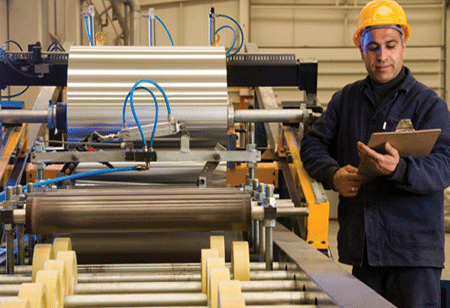By Dennis Rausch, VP IT, Rea Magnet Wire Company
 Established in 1933, Rea Magnet Wire carries the legacy of being a heritage of innovation and setting the highest industry standards to deliver unwavering commitment of integrity, service and responsiveness to its customers. An alumni of Boston University Dennis Rausch, leads the company as the Vice President and direct and guide the IT Department and key projects of the corporation.
Established in 1933, Rea Magnet Wire carries the legacy of being a heritage of innovation and setting the highest industry standards to deliver unwavering commitment of integrity, service and responsiveness to its customers. An alumni of Boston University Dennis Rausch, leads the company as the Vice President and direct and guide the IT Department and key projects of the corporation.
In process manufacturing environments, the production operator relies heavily on process signals, closed-loop process controls, along with continuous and intermittent product testing results. The systems that would give the operator the very best view into his process certainly exist in the marketplace, but it takes the joint effort of the controls engineering group and the IT department to deliver a fine-tuned, integrated solution in the factory.
It may be easy to visualize how a Manufacturing Execution System can provide a dashboard to an operator in a discrete manufacturing setting. For example, the operator looks at the screen to find the next item in his dispatch list, then completes his work, scans the barcode label and moves the item on to the next operation. While doing so, he is entering quality test results and recording labor hours.
But how would you do this for continuous flow manufacturing? Although there are similarities in techniques for gathering and displaying MES data for discrete and continuous-flow manufacturing, one challenge for the process manufacturer is figuring out how to relate the machine signals in the process to the manufacturing transactional data so that the product information, test results, and lot/serial information can all be tied together.
Pharmaceuticals and food and beverage producers have this challenge; as do wire manufacturing plants. Consider a plant where a dozen or even a hundred manufacturing lines are all producing different products simultaneously in a continuous-flow setting. In this type of setting, you may need to pull together master data from your ERP system and quality data from your shop floor system. Then you must match it all up with the machine signals coming out of your PLC’s that are running the drive motors, extruders, temperature sensors and line speeds.
Manufacturing plants are filled with bright process engineers and talented programmers but they don’t often get a chance to work together. I have seen the benefits of the collaboration between these two departments. And I have seen excellent dashboards developed for the operators to use when controlling these processes. I’m not talking about just any dashboard, but one with visualization of the data that is intuitive and valuable to the operator so he can take action to make setting changes. What I am describing is the type of dashboard that the operator would complain about if it stopped working.
Process and controls engineers must be able to work with the programmers from the IT department and perform integration surgery. It is my experience that rarely do manufacturers have the luxury of implementing systems that are already integrated out-of-the-box. The integration of an ERP system, Shop Floor system, Manufacturing Execution Systems, and Supervisory Control and Data Acquisition (SCADA) systems are often custom built. The reality is that legacy systems will require custom integration.
Consider a manufacturer who employs some sort of SCADA system to control real-time processes and to store historical data like speeds, temperatures, and tank levels. This is often time-based data stored in an operational historian database. This data is usually stored without any attributes attached. Storing attribute information like product number, manufacturing order number, lot number, operator number, and other similar data is absolutely needed to support historical analysis. One key to a successful dashboard is linking the real-time data with transactional data. This is where the magic can happen. A piece of software, like an event manager, can be the bridge between the real-time world of machine signals and the transactional world of Shop Floor and ERP systems. By using an event manager, the controls engineer and the software programmer can build solutions to an otherwise undiscovered view of the process.
The fourth industrial revolution is under way. McKinsey & Company experts interviewed executives at Robert Bosch and produced a report that described how Industry 4.0 is creating an information system out of the physical world through sensors and actuators that are networked together using Internet Protocol. However, there are barriers for many companies to upgrade their factories with what is the Internet-of-Things. Some of the barriers are due to network security concerns, or determining payback of the upfront cost, or the ability to provide real-time feedback to the operator who is running the production line.
At Rea Magnet Wire Company, Inc., the cooperation of the Controls Engineers and the Programmers in the IT Department began many years ago. Rea operates several magnet wire factories in North America. For a period of ten or more years, both groups fell under the management of a single person. This centralized management allowed for adoption of key security concepts like creating virtual LANS (VLANS) to separate the business network from the PLC data traffic. The arrangement also provided for timely software patching of SCADA servers and provided tight control and standardization of data retention and data backup procedures. Over time, elaborate integration of machine signals and quality test data had emerged at Rea. This cooperation also enabled the Controls Engineer to build dashboards that brought together ERP data, SPC data, and real-time machine signals. Furthermore, the operator could use his dashboard to more quickly make adjustments to the production line and center the process between the manufacturing limits.

The Internet-of-Things will make its way into your factory soon enough. In order to make way for a real return on your investment in this technology, be sure the IT Programmers and the Controls and Automation Engineers are on the same page as to priorities and objectives of the manufacturing company. They should always be working together and working to complement each group’s skills. At the end of the day, it is about reducing variation, reducing costs and quickly reacting to changes to the process inputs. Through joint efforts, these two groups can build incredibly valuable solutions.
Managing huge amounts of data will require discipline and analytical talent. Once you have the IT Programmers and the Controls Engineers working under a common management structure you should start looking for mathematicians and data analysts. It will take the skills of all of these to solve your manufacturing problems.
We use cookies to ensure you get the best experience on our website. Read more...